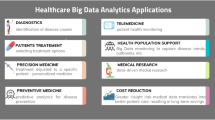Abstract
A hospital information system (HIS) is an information system developed to manage the administrative, financial and clinical aspects of a hospital. Introduced in the 2000’s in large-scale hospitals, HIS has resulted in a dramatic change in the the clinical environment. HIS stores all the histories of clinical activities in a hospital, including electronic patient records, laboratory data, and X-rays, for example. The advantage of HIS is that all the data are input through the network service and can be retrieved from the terminals inside the hospital. Two of the most important roles of HIS is to transfer clinical orders issued by doctors and nurses to other division and to store results of executed orders. Thus, the numbers of issued and executed orders will reflect the clinical activities in large hospitals. This paper proposes a visualization technique, called order trajectory analysis which visualize the temporal sequences of the number of orders. We applied this technique to monitoring clinical workflow: comparison of order trajectories of different divisions confirmed a problem with issuance of orders in one division. We developed the solutions to the problems and used the order trajectories to check whether the problem was solved or not. Transitions of order trajectories show that the proposed technique can be used for monitoring whether the solution is effective or not.















Similar content being viewed by others
Notes
This example is cited from the paper on statistical quality management of software [1].
References
Kawamura, T., Kimura, T., & Tsumoto, S. (2014). Estimation of service quality of a hospital information system using a service log. Review of Socionetwork Strategies, 8(2), 53–68. https://doi.org/10.1007/s12626-014-0044-x.
Miniati, R., Frosini, F., Cecconi, G., Dori, F., & Gentili, G. (2014). Development of sustainable models for technology evaluation in hospital. Technology and Health Care, 22, 729–739. https://doi.org/10.3233/THC-140847.
Shortliffe, E., & Cimino, J. (Eds.). (2006). Biomedical informatics: Computer applications in health care and biomedicine (3rd ed.). Springer.
Tsumoto, S., & Hirano, S. (2011). Detection of risk factors using trajectory mining. Journal of Intelligent Information Systems, 36(3), 403–425. https://doi.org/10.1007/s10844-009-0114-7.
Tsumoto, S., Iwata, H., Hirano, S., & Tsumoto, Y. (2014). Similarity-based behavior and process mining of medical practices. Future Generation Computer System, 33, 21–31. https://doi.org/10.1016/j.future.2013.10.014.
Tsumoto, Y., & Tsumoto, S. (2010). Exploratory univariate analysis on the characterization of a university hospital: A preliminary step to data-mining-based hospital management using an exploratory univariate analysis of a university hospital. The Review of Socionetwork Strategies, 4(2), 47–63. https://doi.org/10.1007/s12626-010-0014-x.
Tsumoto, Y., & Tsumoto, S. (2011). Correlation and regression analysis for characterization of university hospital. The Review of Socionetwork Strategies, 5(2), 43–55. https://doi.org/10.1007/s12626-010-0020-z.
Acknowledgements
This research was supported by a Grant-in-Aid for Scientific Research (B) 18H03289 from the Japan Society for the Promotion of Science (JSPS).
Author information
Authors and Affiliations
Corresponding author
Ethics declarations
Conflict of interest
On behalf of all authors, the corresponding author states that there are no conflicts of interest.
Additional information
Publisher's Note
Springer Nature remains neutral with regard to jurisdictional claims in published maps and institutional affiliations.
This research was supported by a Grant-in-Aid for Scientific Research (B) 18H03289 from the Japan Society for the Promotion of Science (JSPS).
Rights and permissions
About this article
Cite this article
Tsumoto, S., Kimura, T. & Hirano, S. Order Trajectory Analysis for Monitoring Clinical Process. Rev Socionetwork Strat 16, 53–70 (2022). https://doi.org/10.1007/s12626-021-00096-3
Received:
Accepted:
Published:
Issue Date:
DOI: https://doi.org/10.1007/s12626-021-00096-3




